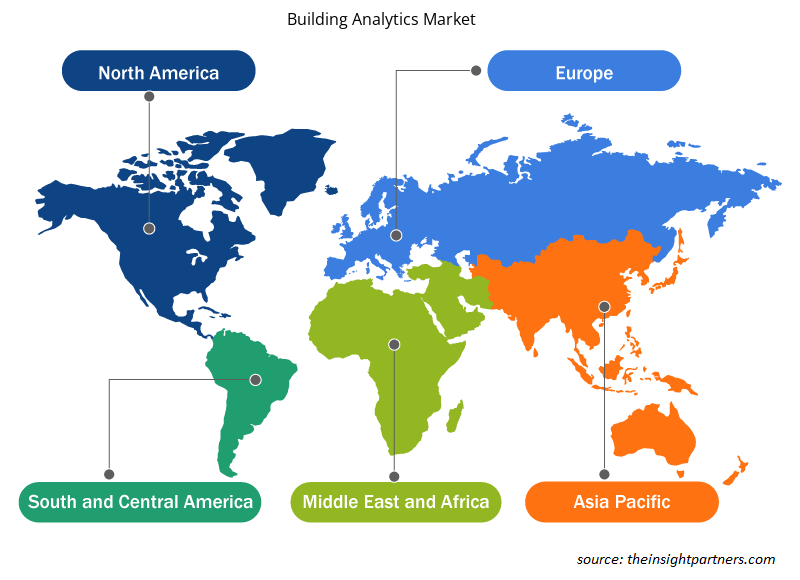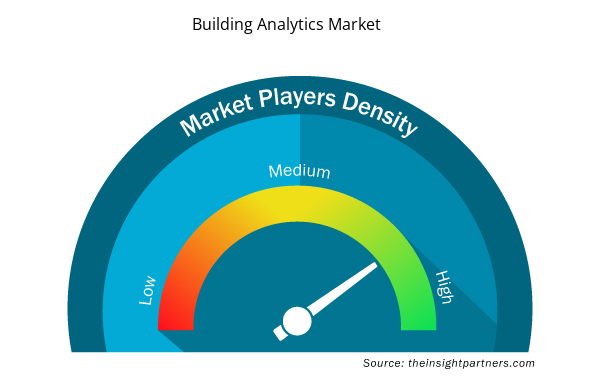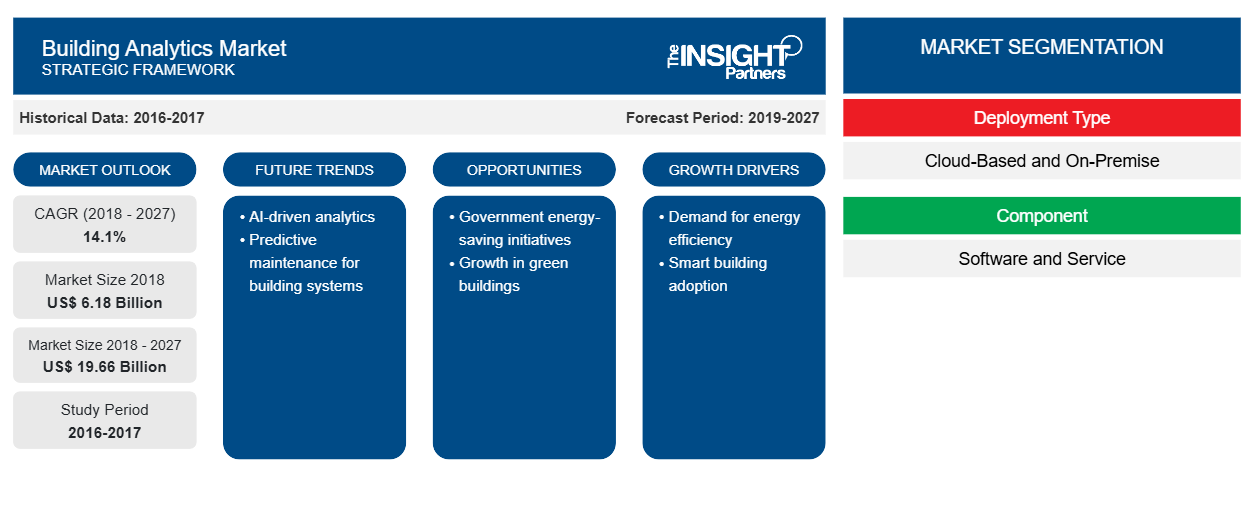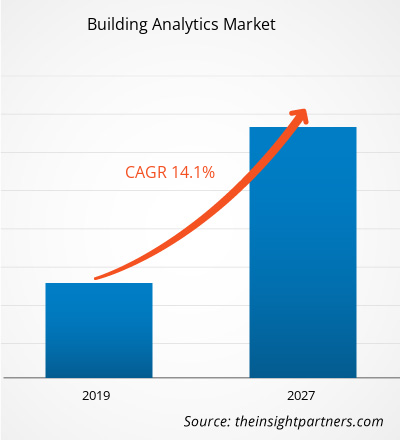世界のビル分析市場は2018年に61億8,140万米ドルと評価され、2019年から2027年の間に14.1%のCAGRで成長すると予想されています。
ビル分析市場は世界中で成長を遂げており、エネルギー価格の上昇、ビルのエネルギーガイドラインの厳格化、そしてビルおよび施設管理の最大限の運用効率の達成が、今後数年間の主要な市場推進力になると予想されています。
このレポートは、展開タイプ、コンポーネント、建物タイプ、およびアプリケーションに基づいて、建物分析市場の詳細なセグメンテーションに焦点を当てています。レポートの地理的セグメンテーションは、北米、ヨーロッパ、アジア太平洋 (APAC)、中東およびアフリカ (MEA)、南米 (SA) の 5 つの主要地域をカバーしています。地域市場は、それぞれの国によってさらに細分化されています。アプリケーション別では、エネルギー管理が 2018 年の建物分析市場で最大のシェアを占めました。
要件に合わせてレポートをカスタマイズする
このレポートの一部、国レベルの分析、Excelデータパックなど、あらゆるレポートを無料でカスタマイズできます。また、スタートアップや大学向けのお得なオファーや割引もご利用いただけます。
- このレポートの主要な市場動向を入手してください。この無料サンプルには、市場動向から見積もりや予測に至るまでのデータ分析が含まれます。
このレポートは、詳細な市場セグメンテーションとともに、世界のビル分析市場の概要を提供することを目的としています。また、現在のビル分析市場のシナリオを分析し、2027年までの市場を予測します。レポートでは、予測期間中にビル分析市場に影響を与える市場動向を取り上げています。さらに、レポートでは、すべての地理的地域に関して、ビル分析市場における競争シナリオ、地理的傾向、機会を分析しています。レポートには、ビル分析市場の主要企業の詳細な企業プロファイルと市場戦略も含まれています。レポートでは、レポートでプロファイルされているすべての企業のPEST分析とSWOT分析も提供しています。
現在、ヨーロッパ地域のビル分析市場の浸透率は、世界中の他のどの市場よりも高くなっています。2012年に発効した欧州連合のエネルギー効率指令は、EUが2020年までに20%のエネルギー効率目標を達成するのを支援するための一連の義務的措置を確立しました。この指令は、すべてのEU諸国に、生産から最終消費まで、エネルギーチェーン全体でエネルギーをより効率的に使用することを求めています。また、2016年には、2030年までに30%のエネルギー効率目標を新たに設定し、この新しい目標を達成するための措置を含むエネルギー効率指令の更新が提案されました。EUでは、ビルが総エネルギー消費量の約40%、総CO2排出量の36%を占めています。また、EUのビルの約35%は築50年以上であり、ビルストックの約75%はエネルギー効率が悪いですが、毎年ビルストックの0.4〜1.2%のみが修復されています。したがって、既存の建物の修復を増やすことで、大幅なエネルギー節約につながる可能性が高まります。このような事実は、建物分析市場の成長に豊かな機会をもたらします。
ビルディングアナリティクス市場の地域別インサイト
予測期間を通じてビル分析市場に影響を与える地域的な傾向と要因は、Insight Partners のアナリストによって徹底的に説明されています。このセクションでは、北米、ヨーロッパ、アジア太平洋、中東およびアフリカ、南米および中米にわたるビル分析市場のセグメントと地理についても説明します。

- ビル分析市場の地域別データを入手
ビルディングアナリティクス市場レポートの範囲
| レポート属性 | 詳細 |
|---|---|
| 2018年の市場規模 | 61億8千万米ドル |
| 2027年までの市場規模 | 196.6億米ドル |
| 世界のCAGR(2018年 - 2027年) | 14.1% |
| 履歴データ | 2016-2017 |
| 予測期間 | 2019-2027 |
| 対象セグメント | 展開タイプ別
|
| 対象地域と国 | 北米
|
| 市場リーダーと主要企業プロフィール |
|
ビルディングアナリティクス市場のプレーヤー密度:ビジネスダイナミクスへの影響を理解する
ビルディング アナリティクス市場は、消費者の嗜好の変化、技術の進歩、製品の利点に対する認識の高まりなどの要因により、エンド ユーザーの需要が高まり、急速に成長しています。需要が高まるにつれて、企業は提供内容を拡大し、消費者のニーズを満たすために革新を起こし、新たなトレンドを活用し、市場の成長をさらに促進しています。
市場プレーヤー密度とは、特定の市場または業界内で活動している企業または会社の分布を指します。これは、特定の市場スペースに、その市場規模または総市場価値に対してどれだけの競合相手 (市場プレーヤー) が存在するかを示します。
ビル分析市場で事業を展開している主要企業は次のとおりです。
- シュナイダーエレクトリック
- インターナショナル・ビジネス・マシーンズ(IBM)コーポレーション
- スカイファウンドリー
- 環境システム株式会社
- ENGIE インサイトサービス株式会社
免責事項:上記の企業は、特定の順序でランク付けされていません。

- ビルディングアナリティクス市場のトップキープレーヤーの概要を入手
この市場で活動している主要企業には、(アルファベット順で)Acorn Engineering Group Limited、Arup Group、AT Kearney、Buildingiq、Buildinglogix、Buildpulse、Coppertree Analytics、Crestron Electronics、Delta Electronics、Ecovox、Energy Advantage、Enernoc、Engie Insight、Environmental Systems Inc.、General Electric、Gooee、Gridpoint、Honeywell、IBM Corporation、Iconics、Schneider Electric、Senseware、Siemens、SkyFoundry、Waibel Energy Systems、Xchanging PLC(CSC Computer Sciences International Operations Limited)などがあります。
- 過去2年間の分析、基準年、CAGRによる予測(7年間)
- PEST分析とSWOT分析
- 市場規模価値/数量 - 世界、地域、国
- 業界と競争環境
- Excel データセット



Report Coverage
Revenue forecast, Company Analysis, Industry landscape, Growth factors, and Trends

Segment Covered
This text is related
to segments covered.

Regional Scope
North America, Europe, Asia Pacific, Middle East & Africa, South & Central America

Country Scope
This text is related
to country scope.
Trends and growth analysis reports related to Technology, Media and Telecommunications : READ MORE..
The List of Companies
1. Schneider Electric
2. International Business Machines (IBM) Corporation
3. SkyFoundry
4. Environmental Systems, Inc.
5. ENGIE Insight Services Inc
6. Senseware, Inc.
7. Gooee
8. Acorn Engineering Group Limited
9. Waibel Energy Systems
10. BuildingIQ, Inc
11. Siemens AG
12. General Electric (GE)
13. Iconics, Inc.
14. Coppertree Analytics
15. Delta Electronics
The Insight Partners performs research in 4 major stages: Data Collection & Secondary Research, Primary Research, Data Analysis and Data Triangulation & Final Review.
- Data Collection and Secondary Research:
As a market research and consulting firm operating from a decade, we have published and advised several client across the globe. First step for any study will start with an assessment of currently available data and insights from existing reports. Further, historical and current market information is collected from Investor Presentations, Annual Reports, SEC Filings, etc., and other information related to company’s performance and market positioning are gathered from Paid Databases (Factiva, Hoovers, and Reuters) and various other publications available in public domain.
Several associations trade associates, technical forums, institutes, societies and organization are accessed to gain technical as well as market related insights through their publications such as research papers, blogs and press releases related to the studies are referred to get cues about the market. Further, white papers, journals, magazines, and other news articles published in last 3 years are scrutinized and analyzed to understand the current market trends.
- Primary Research:
The primarily interview analysis comprise of data obtained from industry participants interview and answers to survey questions gathered by in-house primary team.
For primary research, interviews are conducted with industry experts/CEOs/Marketing Managers/VPs/Subject Matter Experts from both demand and supply side to get a 360-degree view of the market. The primary team conducts several interviews based on the complexity of the markets to understand the various market trends and dynamics which makes research more credible and precise.
A typical research interview fulfils the following functions:
- Provides first-hand information on the market size, market trends, growth trends, competitive landscape, and outlook
- Validates and strengthens in-house secondary research findings
- Develops the analysis team’s expertise and market understanding
Primary research involves email interactions and telephone interviews for each market, category, segment, and sub-segment across geographies. The participants who typically take part in such a process include, but are not limited to:
- Industry participants: VPs, business development managers, market intelligence managers and national sales managers
- Outside experts: Valuation experts, research analysts and key opinion leaders specializing in the electronics and semiconductor industry.
Below is the breakup of our primary respondents by company, designation, and region:

Once we receive the confirmation from primary research sources or primary respondents, we finalize the base year market estimation and forecast the data as per the macroeconomic and microeconomic factors assessed during data collection.
- Data Analysis:
Once data is validated through both secondary as well as primary respondents, we finalize the market estimations by hypothesis formulation and factor analysis at regional and country level.
- Macro-Economic Factor Analysis:
We analyse macroeconomic indicators such the gross domestic product (GDP), increase in the demand for goods and services across industries, technological advancement, regional economic growth, governmental policies, the influence of COVID-19, PEST analysis, and other aspects. This analysis aids in setting benchmarks for various nations/regions and approximating market splits. Additionally, the general trend of the aforementioned components aid in determining the market's development possibilities.
- Country Level Data:
Various factors that are especially aligned to the country are taken into account to determine the market size for a certain area and country, including the presence of vendors, such as headquarters and offices, the country's GDP, demand patterns, and industry growth. To comprehend the market dynamics for the nation, a number of growth variables, inhibitors, application areas, and current market trends are researched. The aforementioned elements aid in determining the country's overall market's growth potential.
- Company Profile:
The “Table of Contents” is formulated by listing and analyzing more than 25 - 30 companies operating in the market ecosystem across geographies. However, we profile only 10 companies as a standard practice in our syndicate reports. These 10 companies comprise leading, emerging, and regional players. Nonetheless, our analysis is not restricted to the 10 listed companies, we also analyze other companies present in the market to develop a holistic view and understand the prevailing trends. The “Company Profiles” section in the report covers key facts, business description, products & services, financial information, SWOT analysis, and key developments. The financial information presented is extracted from the annual reports and official documents of the publicly listed companies. Upon collecting the information for the sections of respective companies, we verify them via various primary sources and then compile the data in respective company profiles. The company level information helps us in deriving the base number as well as in forecasting the market size.
- Developing Base Number:
Aggregation of sales statistics (2020-2022) and macro-economic factor, and other secondary and primary research insights are utilized to arrive at base number and related market shares for 2022. The data gaps are identified in this step and relevant market data is analyzed, collected from paid primary interviews or databases. On finalizing the base year market size, forecasts are developed on the basis of macro-economic, industry and market growth factors and company level analysis.
- Data Triangulation and Final Review:
The market findings and base year market size calculations are validated from supply as well as demand side. Demand side validations are based on macro-economic factor analysis and benchmarks for respective regions and countries. In case of supply side validations, revenues of major companies are estimated (in case not available) based on industry benchmark, approximate number of employees, product portfolio, and primary interviews revenues are gathered. Further revenue from target product/service segment is assessed to avoid overshooting of market statistics. In case of heavy deviations between supply and demand side values, all thes steps are repeated to achieve synchronization.
We follow an iterative model, wherein we share our research findings with Subject Matter Experts (SME’s) and Key Opinion Leaders (KOLs) until consensus view of the market is not formulated – this model negates any drastic deviation in the opinions of experts. Only validated and universally acceptable research findings are quoted in our reports.
We have important check points that we use to validate our research findings – which we call – data triangulation, where we validate the information, we generate from secondary sources with primary interviews and then we re-validate with our internal data bases and Subject matter experts. This comprehensive model enables us to deliver high quality, reliable data in shortest possible time.


 このレポートの無料サンプルを入手する
このレポートの無料サンプルを入手する